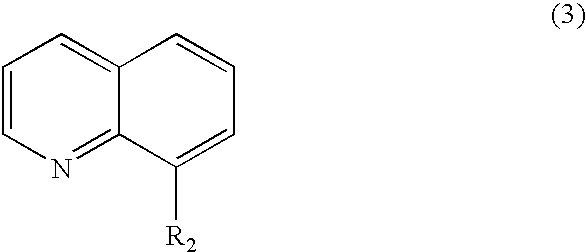Method for producing biphenyl and its derivatives
- Summary
- Abstract
- Description
- Claims
- Application Information
AI Technical Summary
Benefits of technology
Problems solved by technology
Method used
Image
Examples
example 1
[0051]Into a 20 ml pear flask was weighed 1.27 g (6.5 mmol) of dimethyl phthalate, and 0.05 mmol of palladium trifluoroacetate (Pd(OCOCF3)2), 0.015 mmol of copper acetate monohydrate (Cu(OAc)2.H2O), and 0.05 mmol of 2-pyridinecarboxylic acid (represented by formula (6); hereinafter abbreviated as pyca) were put therein as catalyst components. A Liebig condenser was fitted to the flask. The inner atmosphere was displaced with grade A air with a dew point of −80° C. or lower under atmospheric pressure and sealed the flask off with a balloon containing air as a cap. Cooling water at 5° C. was circulated through the Liebig condenser. The flask was maintained in a silicone oil bath previously heated to 200° C. for a reaction time of 6 hours while stirring with a magnetic stirrer at 600 rpm. After the reaction, the flask was cooled with water, and the contained gas was purged. The contents were washed with acetone and analyzed by gas chromatography to determine the conversion of dimethyl ...
example 2
[0053]The procedures of Example 1 were followed, except for replacing Pd(OCOCF3)2 with the same molar quantity of palladium acetate (Pd(OAc)2). The analytical results are shown in Table 1.
example 3
[0055]In 10 ml of acetone was dissolved 0.20 mmol of bis(acetylacetonato)palladium (Pd(acac)2, wherein acac stands for acetylacetonato group), and 0.20 mmol of pyca was added to the solution at room temperature. The solvent was removed from the solution by evaporator to give a crude complex, which was washed three times with 10 ml portions of hexane to remove any residual acetylacetone and dried at room temperature under reduced pressure to obtain a complex, Pd(pyca)(acac). The procedures of Example 1 were followed, except for using 0.05 mmol of the resulting complex in place of Pd(OCOCF3)2 and pyca. The analytical results are shown in Table 1.
PUM
| Property | Measurement | Unit |
|---|---|---|
| temperature | aaaaa | aaaaa |
| temperature | aaaaa | aaaaa |
| temperature | aaaaa | aaaaa |
Abstract
Description
Claims
Application Information
 Login to View More
Login to View More - R&D
- Intellectual Property
- Life Sciences
- Materials
- Tech Scout
- Unparalleled Data Quality
- Higher Quality Content
- 60% Fewer Hallucinations
Browse by: Latest US Patents, China's latest patents, Technical Efficacy Thesaurus, Application Domain, Technology Topic, Popular Technical Reports.
© 2025 PatSnap. All rights reserved.Legal|Privacy policy|Modern Slavery Act Transparency Statement|Sitemap|About US| Contact US: help@patsnap.com



